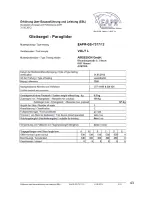
28
i.
Towing and winching
When towing or winching, the glider must be above the pilots head before starting.
In the initial phase the tension should not be too high – a pilot climbing at a flatter angle has
more control.
Tension of more than 90kp is not allowed. In any situation, the maximum permitted tension on
the line must not exceed the pilot’s weight.
The pilot must be informed and aware of the national requirements for towing. This includes
matter such as; tow/winch licence requirements, qualified tow operators, suitability of glider
for towing, if winch and towing-links are certified etc.
In general, the regulated and enforced regulations must to be followed.
j.
Asymmetric and frontal collapses
As with any paraglider collapses can occur. “Active flying” as described in point “f” can help
avoid deformations.
You should always maintain course and direction by weight-shifting away from the collapsed
side. This can be reinforced by applying a small amount of brake on the opposite side to the
deflation. If the collapse stays in, the glider can be re-inflated by pumping the brake on the
collapsed side in a firm and smooth manner. Be aware that the brake travel is shorter when the
glider is collapsed and the glider can stall with less brake input.
If you experience a big collapse while accelerated, the canopy will fall behind the pilot due to
the difference in inertia between the pilot and the canopy. You must wait until you pendulum
back under the canopy before dealing with the deflation. Reacting too early can risk stalling the
glider completely. Release the speed-bar immediately if you have a big collapse during
accelerated flight and, while keeping weight-shift neutral, apply slight brake to the open side.
Let the glider enter a turn if space allows in order to avoid a spin or stall.
To assist in the reopening of a frontal collapse the pilot should pull both brakes equally at the
same time. This also reduces the dive after the glider reopens.
NOTE: Pulling too much brake during a frontal collapse recovery can stall the glider or cause
the glider to revert from the frontal collapse directly into a deep-stall.
k.
Reopening a cravat
In extreme conditions it is possible that the wing tip(s) can become trapped between the lines.
In general, this would happen only after a big uncontrolled collapse or during extreme
manoeuvres.
If this cravat occurs, in the first instance use the techniques described for releasing asymmetric
collapses.
If it fails to release, take hold of the stabilo line and pull hard towards yourself until the
trapped section of the wing is released.
A full-stall should be the last option to reopen a cravat and is a manoeuvre for experienced
pilots only and should be attempted only if there is sufficient altitude. At low altitude it is
important to stabilise the rotation, if any, and if necessary use the reserve (rescue) if this is not
possible.
Summary of Contents for Volt
Page 20: ...36 A ANHANG ANNEX a Übersichtszeichnung Overview ...
Page 21: ...37 b Leinenplan line plan ...
Page 22: ...38 ...
Page 25: ...41 C EBL DDP ...
Page 26: ...42 ...
Page 27: ...43 ...
Page 28: ...44 ...
Page 29: ...45 ...
Page 34: ......



























